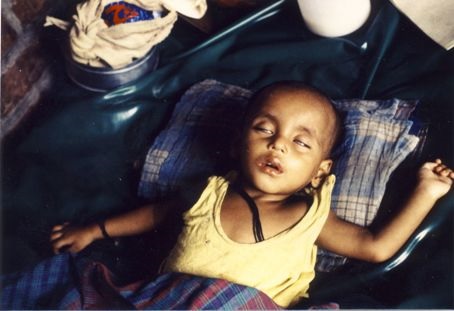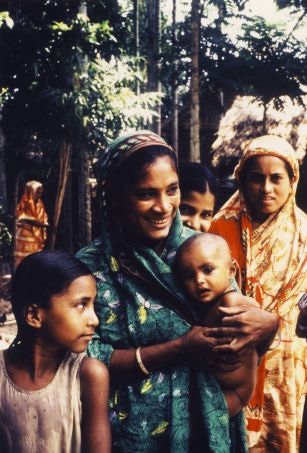
There is a large hole cut in the mattress and a basin underneath that catches his excrement along with the flood of water from his body that is hastening his death. At his side, his mother sits silently, wrapped in a green sari, watching me closely. I look up and to the left and right and as far as I can see in every direction there are cots, black plastic mattresses, children hovering between life and death and terrified, protective women sitting nearby. They come from far and near to save their children – some of whom are sick but relatively strong and others who are barely flesh covered skeletons with the skin stretched taught over their little bones. Most are boys. More often than not, their sisters have been allowed to live or die – God willing – at home.
There is a strange, unpleasantly sweet smell in the air that barely masks the odor of dysentery and a makeshift tent over our heads where only last week there was jungle. The children and their mothers are silent and the only sounds to be heard are the soft murmurings of staff conferring over the treatment of the children. In stark contrast to the volume and drama of the violent deaths glorified by Hollywood and its subsidiaries, in my experience, most people die with barely a whisper. There is no cry to an unjust heaven or swell of music, there is only the quiet, barely noticeable passing of children from the realm of the living into the realm of the dead.

One evening in Dhaka, I received a great gift and was allowed to see the city through the eyes of one of the pioneers. A warm breeze blew over the canal and the lights of downtown started to shine against a darkening sky as we walked. Vandaceous orchids dripped from the trees or were for sale by vendors along the quiet suburban avenue. Below us on the water, women did a last load of laundry, slapping the sheet-like robes on the rocks and pounding them with stones. My companion stopped and with an expansive wave of his hand said, “Tall buildings, paved roads, a bridge over the river Brahmaputra – a booming middle class! What I am amazed at . . . is all of this wealth!” He went on to say that he hated to hear young people gripe about the poverty and lack of amenities, because they had no idea how far the country had come in less than two generations. “There was nothing here. Nothing but people and most of them were starving. . .”
Bangladesh has indeed come far, but still has many miles to go. Far too many of its people remain bound to the land – in sharecropper purgatory – working all year to pay the rent to stay on the land. However lush and bountiful the countryside, it is a rural poorhouse for most of its citizens. Those that try to escape often wind up in an even lower circle of hell – the urban slum – the successful ones can sometimes pick a meager living off of the river. The houseboat has become the new symbol of prosperity and independence, because however poor a lifestyle the river provides it is theirs and it is free. The Bangladeshis are amongst the most industrious and resourceful people that I have ever met. They don’t need a billion-dollar vaccine that will result in another failed attempt to keep cholera at bay, What they needs are more Grameens who will chip away at the poverty by providing more disposable income so the people can better themselves one family at a time.
Coming back to our guest house after our walk along the canal, the pioneer and I sat down to a table bedecked with several Bangladeshi specialties. That night we dined on sweet and sour Lamb Rezala with its almonds, poppy seeds and raisins and chicken curry with pineapples. Plain rice was plentiful as was a biryani with layers of meat, nuts and fruit. I thoroughly enjoyed the meal, feasting along with the other western visitors at the guesthouse, but couldn’t shake the knowledge that outside, hanging on with a white-nailed grip to the margins of the city’s newfound prosperity, hundreds, maybe thousands of children went hungry.
My memories and feelings about my travels in Bangladesh are a tangled wing of extremes such as these. I love the country, its incredible spirit and energy and that wild feeling that almost anything could happen that permeates its cities and countryside. Much of the landscape of modern Bangladeshi society is a direct result of the work done by the early public health pioneers who brought so much more than medicine with them on that houseboat. To the people of Bangladesh they brought the promise of today – for when you give the gift of health to people, you are giving them the future as well. (Words by Laura Kelley; Photo of A Sick Child and Hail Mary! by Laura Kelley)
